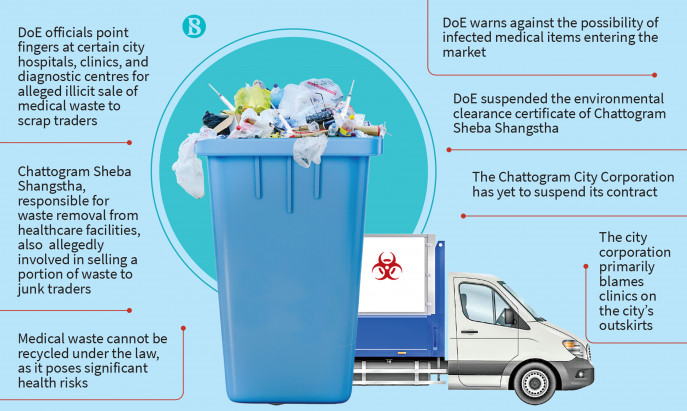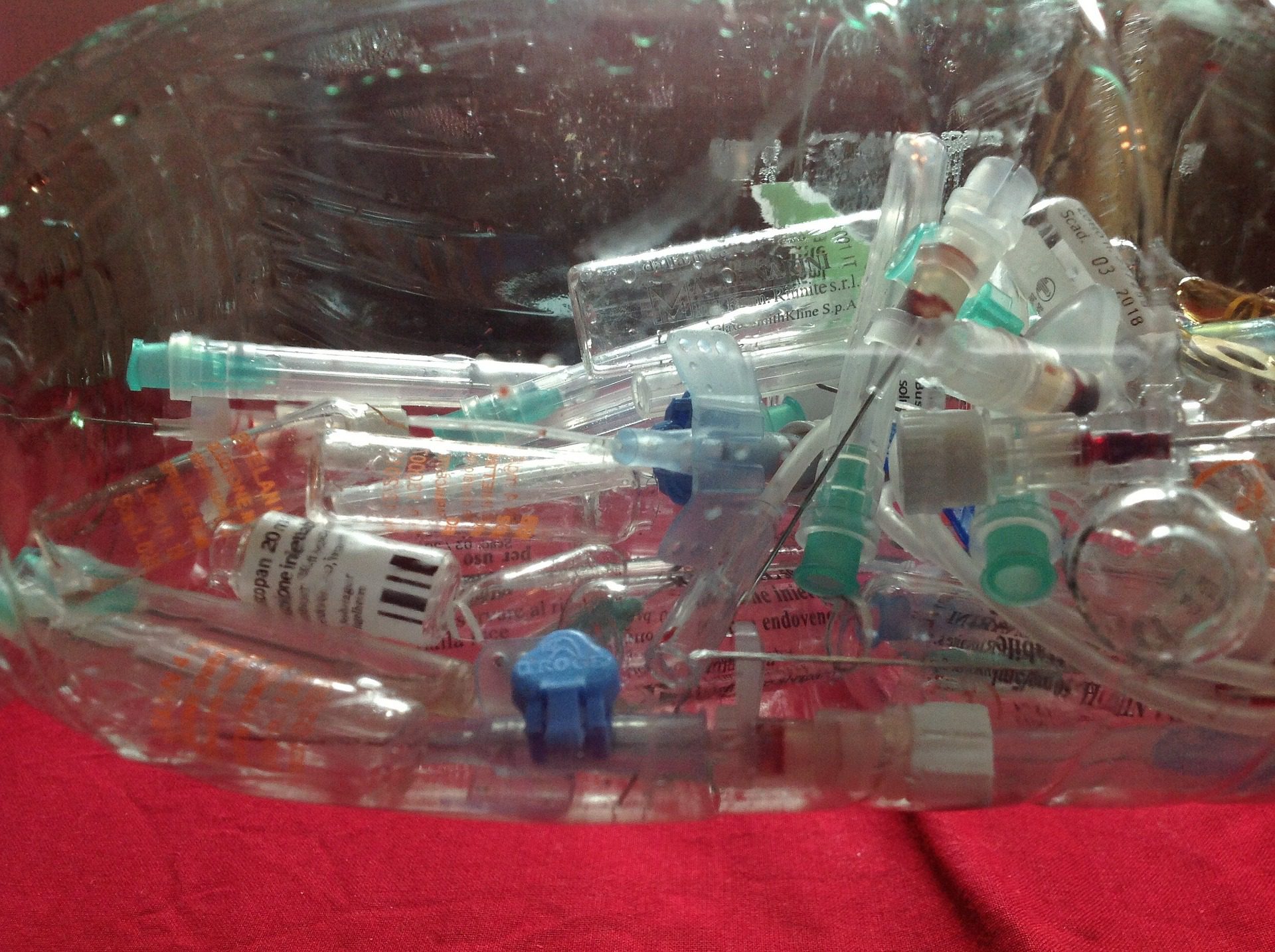Beyond Clean-up: Ensuring Security with Expert Medical Waste Removal
Beyond Clean-up: Ensuring Security with Expert Medical Waste Removal
Blog Article
Minimize Expenses and Make Best Use Of Safety And Security: Effective Medical Garbage Disposal Approaches
Efficient clinical waste disposal techniques are critical for medical care facilities to take full advantage of and decrease costs security. By implementing appropriate partition and classification, efficient packaging and labeling, secure transportation and handling, efficient therapy and disposal approaches, and compliance with regulatory standards, medical care centers can guarantee the risk-free and liable administration of clinical waste.

Appropriate Partition and Classification
Correct partition and categorization are essential elements of efficient clinical garbage disposal approaches, ensuring the safety of healthcare workers, the public, and the environment - medical waste removal services. medical waste disposal services with WasteX. By separating various kinds of medical waste at the factor of generation, medical care facilities can minimize the threat of cross-contamination and prospective harm to communities and people
Among the essential consider appropriate segregation is the recognition and classification of clinical waste. This involves classifying waste into various groups, such as infectious, unsafe, radioactive, or pharmaceutical waste. Each group needs specific handling, storage, and disposal approaches to stop any negative impacts on human health and wellness and the environment.
In addition, appropriate partition also consists of the use of color-coded containers and tags to clearly recognize and distinguish the numerous kinds of medical waste. This aids healthcare workers and waste monitoring personnel to quickly identify and deal with the waste suitably. Red containers may be utilized for transmittable waste, while yellow containers might be designated for dangerous waste.
Along with partition, proper categorization likewise entails the correct packaging and containment of clinical waste. This makes certain that waste is securely stored and delivered without posturing any risks to individuals or the atmosphere. Utilizing puncture-resistant and watertight containers, along with properly sealing and classifying them, aids to stop any unintentional exposure or release of dangerous compounds.
Effective Packaging and Identifying
Effective packaging and labeling play an important duty in making certain the efficient and risk-free disposal of clinical waste. Appropriate product packaging is vital to stop leak, breakage, or spillage during transport and handling. It aids to lessen the danger of contamination and safeguards healthcare workers, waste monitoring employees, and the setting from prospective risks.
Medical waste should be packaged in tough and watertight containers that are immune to penetrate and breakage. These containers should be properly secured to stop any leak. In addition, the packaging should have the ability to stand up to the conditions of transport, including temperature variants and misuse.
Classifying is similarly essential as it gives vital info concerning the components of the waste and any possible risks related to it. The tags should consist of the name of the health care facility, the sort of waste, and any special delivery instructions. Standardized and clear labeling makes sure that waste management employees can easily recognize and handle the waste suitably.
Efficient product packaging and labeling also aid in the correct segregation and classification of clinical waste. Clear labeling enables simple identification of various waste streams, such as infectious waste, sharps, or pharmaceutical waste. This assists in streamlining the disposal process and making certain that the waste is treated or taken care of according to regulative standards.
Safe Transportation and Handling
Guaranteeing the secure transportation and handling of medical waste is of utmost value in order to protect against any prospective wellness and environmental risks. Medical waste, such as sharps, infected products, and pharmaceutical waste, must be correctly packaged and managed to decrease the risk of exposure to damaging materials and virus.
Transferring medical waste needs conformity with stringent laws and standards established by environmental agencies and local authorities. These policies aim to secure the health and wellness and safety and security of employees entailed in waste monitoring and protect against the launch of hazardous products right into the atmosphere.
To make sure secure transport, medical waste must be put in leak-proof and puncture-resistant containers that are correctly sealed and labeled. These containers should be safeguarded in a means that protects against spills or damage throughout transit (medical waste removal services). Furthermore, it is vital to utilize specific vehicles equipped with ideal safety and security functions to transfer medical waste. These lorries need to have appropriate ventilation and be designed to protect against leak or contamination.
Managing clinical waste also requires appropriate training and adherence to safety and security protocols. Personnel associated with the handling of clinical waste need to wear suitable individual safety tools (PPE) such as dress, masks, and handwear covers to minimize the risk of exposure. They ought to likewise comply with stringent health techniques to avoid the spread of infections and ensure the safe disposal of waste.
Effective Treatment and Disposal Methods
Executing suitable treatment and disposal techniques is crucial in handling medical waste properly and reducing potential health and environmental risks. Medical waste, which includes sharps, infectious products, chemicals, and drugs, can posture substantial threats otherwise managed and thrown away appropriately. There are a number of treatment and disposal methods available that stick to governing standards and promote safe techniques.
One typical approach is incineration, which entails burning the waste at heats. Incineration is special info effective in destroying microorganisms and minimizing the volume of waste, however it can launch dangerous toxins right into the air otherwise appropriately managed. It is crucial to use contemporary incinerators equipped with exhaust control modern technologies.
An additional technique is autoclaving, which utilizes heavy steam and pressure to sanitize the waste. Autoclaving works in eliminating microorganisms and decreasing the volume of waste, yet it calls for cautious monitoring and upkeep to make certain appropriate functioning. The sterilized waste can after that be safely gotten rid of in a landfill.
Chemical therapy is one more option, which entails utilizing disinfectants or various other click this chemicals to reduce the effects of pathogens. This approach is frequently used for fluid waste, such as lab specimens. Nonetheless, it is essential to use proper chemicals and comply with correct procedures to ensure efficient treatment and protect against environmental contamination.

Compliance With Regulatory Guidelines
Sticking to regulatory standards is essential in making sure proper compliance with clinical garbage disposal methods. These standards are established to secure public health, avoid ecological contamination, and keep workplace security. Conformity with regulatory guidelines is vital for medical care facilities, as non-compliance can lead to charges, penalties, and reputational damage.
Regulative guidelines detail the correct handling, storage, transportation, and disposal of medical waste. They supply details instructions on packaging requirements, labeling, and record-keeping. These guidelines likewise attend to the partition of various waste streams, such as sharps, infectious waste, and pharmaceutical waste. Healthcare facilities should guarantee that their waste administration methods straighten with these standards to look these up decrease the threat of direct exposure to unsafe products and protect against the spread of infections.
To maintain compliance, medical care centers need to develop detailed waste administration programs that consist of personnel training, regular audits, and ongoing monitoring. It is essential to maintain current with any kind of modifications or updates to regulatory guidelines, as techniques might develop in time. By staying educated and carrying out appropriate protocols, healthcare centers can minimize the potential for regulatory offenses and secure the health and wellness of their team, clients, and the surrounding area.
Final Thought
Finally, applying efficient medical garbage disposal techniques is essential for decreasing expenses and taking full advantage of safety. Appropriate segregation and classification, efficient product packaging and labeling, safe transportation and handling, and reliable treatment and disposal approaches are crucial actions to guarantee conformity with regulatory standards. medical waste removal services. By sticking to these techniques, medical care facilities can secure the environment and public health and wellness while likewise reducing monetary worries connected with medical waste monitoring
By executing correct partition and categorization, effective product packaging and labeling, secure transportation and handling, efficient therapy and disposal approaches, and compliance with regulative standards, medical care centers can guarantee the liable and safe management of medical waste. Red containers might be made use of for transmittable waste, while yellow containers may be designated for dangerous waste.
Standard and clear labeling makes certain that waste monitoring personnel can easily identify and deal with the waste properly. (medical waste disposal services with WasteX)
Clear labeling enables for easy recognition of various waste streams, such as contagious waste, sharps, or pharmaceutical waste. These guidelines additionally attend to the segregation of different waste streams, such as sharps, transmittable waste, and pharmaceutical waste.
Report this page